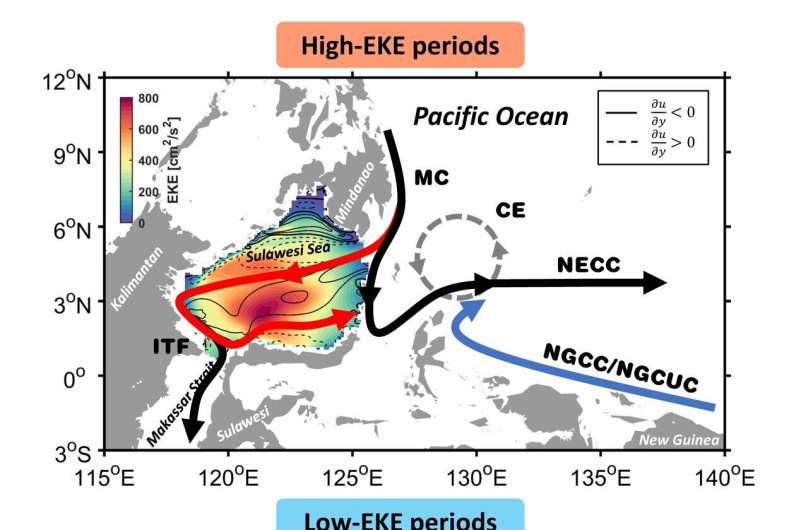Study reveals dynamics of interannual eddy kinetic energy variability in Sulawesi Sea

Mesoscale eddies are essential for the distribution of thermohaline and biochemical properties, and act as a bridge for the energy cascade between large-scale circulation and submesoscale dynamical processes.
The Sulawesi Sea is the primary entrance for the western path of the Indonesian Throughflow and the most active region of mesoscale eddies in the Indonesian seas. However, the interannual evolution of eddy kinetic energy (EKE, an indicator of eddy activity intensity) in the Sulawesi Sea is still unclear.
Recently, a joint research team led by Prof. Yin Baoshu from the Institute of Oceanology of the Chinese Academy of Sciences (IOCAS) and Prof. Feng Ming from CSIRO Oceans & Atmosphere has revealed the dynamics of interannual EKE variability in the Sulawesi Sea.
This study was published in the Journal of Geophysical Research: Oceans.
According to the outputs of Ocean Forecasting Australia Model version 3, the prominent interannual EKE variability in the Sulawesi Sea was modulated by the Mindanao Current intrusion. The barotropic instability of cyclonic loop current in the Sulawesi Sea, regulated by the fluctuation of upstream Mindanao Current intrusion transport (MCIT), was responsible for the interannual EKE variations.
The paths of two western boundary currents, namely Mindanao Current and New Guinea Coastal Current and Undercurrent (NGCC/NGCUC), are the primary driving forces to modulate the Mindanao Current intrusion.
During high-EKE periods, the MCIT increases 0.60 Sv (1 Sv≡106 m3s-1) when the NGCC/NGCUC weakens and the Mindanao Current retroflection extends to south of 5°N, which strengthens the barotropic energy conversion from mean kinetic energy to EKE in the Sulawesi Sea. During low-EKE periods, the NGCC/NGCUC is intensified and the Mindanao Current retroflection retreats to a northernmost path, leading to a decrease of 0.58 Sv in MCIT and thus a low EKE level in the Sulawesi Sea.
"In addition, cyclonic and anticyclonic mesoscale eddies to east of the Sulawesi Sea in the western Pacific can facilitate and suppress the Mindanao Current intrusion, respectively," said Hao Zhanjiu, first author of the study.
"Our study highlights the significance of the nonlinear dynamics of western boundary currents in modulating eddy activities in the formation region of the Indonesian Throughflow," said Prof. Xu Zhenhua, one of the corresponding authors of the study.
More information: Zhanjiu Hao et al, Dynamics of Interannual Eddy Kinetic Energy Variability in the Sulawesi Sea Revealed by OFAM3, Journal of Geophysical Research: Oceans (2022). DOI: 10.1029/2022JC018815
Provided by Chinese Academy of Sciences



















